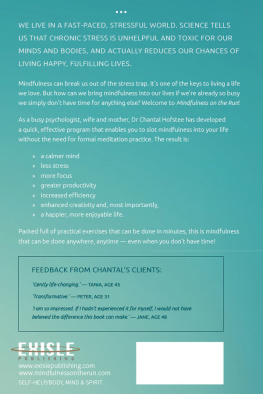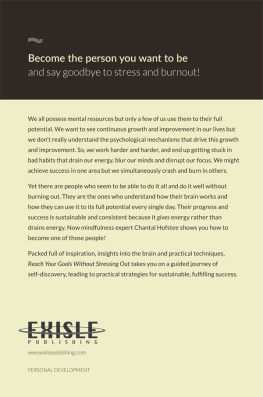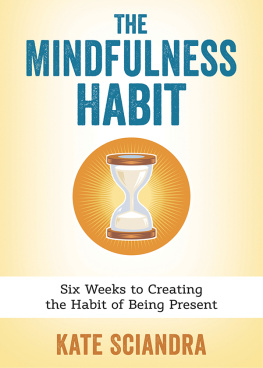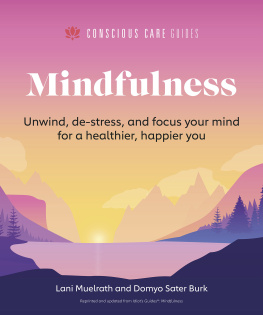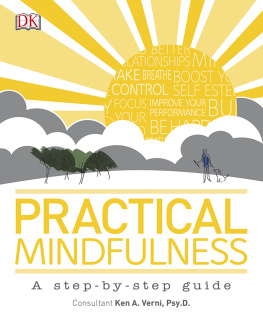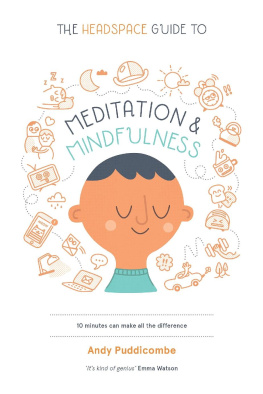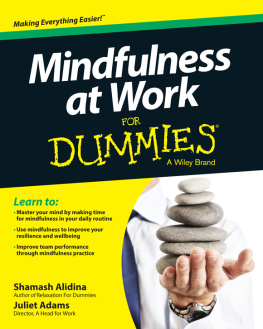

Dr Chantal Hofstee is a clinical psychologist who works in both private and corporate sectors. She combines Cognitive Behavioural Therapy techniques with research-based mindfulness training to equip her clients with easy-to-use skills that transform their lives. Through her company Renew Your Mind, she and her team provide mindfulness courses and business training to enable people to take control of stress, improve focus, solve problems and become more innovative. Find out more about Chantal at: www.mindfulnessontherun.com
To Pieter,
Thank you.
Contents
Introduction:
MINDFULNESS FOR BUSY PEOPLE
When was the last time you were not busy? How often do you feel stressed? Imagine that you could navigate your most challenging times with a mind that was calm and focused and filled with positive thoughts what would be different?
Would you feel better? Stay calm when things dont go according to plan? Be more effective at work? Would your relationships be different? Would you be kinder to yourself?
Its easy to see stress as a normal part of life. But it does not have to be that way. I used to feel tired and stressed most of the time. My life felt like a never-ending race to do more, do better and tick the boxes on my to-do list, only to then add new things to it. Negative chatter and worries crowded my thoughts and I needed to achieve more and more to feel good about myself. All of this made it hard to be present and enjoy life.
I am grateful that those days are gone, and I have mindfulness practice to thank for it.
Mindfulness is very effective in reducing stress, and it doesnt have to be difficult or time-consuming; you dont have to go away on a retreat or sit still for 20 minutes a day to calm your busy mind. Mindfulness can be simple and practical. In this book I will show how you can practice mindfulness on the run by fitting it into your everyday activities so you can enjoy a busy life without a busy mind.
Research shows that mindfulness effectively:
| Reduces | Increases |
| Stress | Physical health |
| Anxiety | Emotion regulation |
| Depression | Productivity |
| Impulsivity | Overall wellbeing and happiness |
These techniques changed me from a stressed and anxious over-committer to a content and mindful partner, parent and entrepreneur and they could do the same for you.
This book will:
Give you insights into the functioning of your brain.
Help you understand the origins of your unhelpful patterns that cause stress.
Teach you practical mindfulness techniques that you can use in the midst of busy days.
Each chapter has a section called Insight inspiration. It contains questions that are designed to help you relate the theory to your personal life. This creates powerful insights, which increase the effectiveness of the mindfulness exercises. You might want to use a notebook or journal to write down your answers to the questions in this section.
To reach results more quickly and easily, I recommend the Mindfulness on the Run CD or download. It has recordings of the mindfulness exercises youll find in this book. This way you dont have to remember the steps, you just turn on the track of the technique you want to practise and hear my voice guiding you through the steps. Your practice couldnt be easier.
You can purchase the CD or download it from our website: www.mindfulnessontherun.com
Today I am a clinical psychologist. But I first discovered mindfulness practice years ago, when I was a student, and it became a very effective stress-reduction tool through my university days. Years later, however, I found myself highly stressed, trying to juggle my roles as a partner, a parent and a principal in a busy psychology practice. I just couldnt find the time to keep up my mindfulness practice, which led to a dilemma:
You need mindfulness practice the most when you are busy and stressed, but during those times you cannot go on a retreat or set aside 20 minutes a day to meditate you are simply too busy!
My life was not going to change any time soon, so I had two options: either give up practising mindfulness, or create a way of practising mindfulness that would fit in with my busy lifestyle. This led me to develop the Renew Your Mind method: mindfulness techniques that are practical and highly effective, yet do not require you to sit still and meditate but instead can be done on the run.
Let me share a real-life example of how I use mindfulness on the run to combat stress. Just recently I was packing my things in the morning, and I had exactly 20 minutes before I had to leave the house. I was going to drop off my two-year-old son at his nannys house and then calmly and mindfully make my way to the university where I was invited to teach mindfulness to a group of 32 students.
At the time our house was being renovated, so we were staying with friends. As I was preparing for the day my son was watching a Thomas the Tank Engine DVD in my friends beautiful home office. When all my things were packed, I went to get him and found him drawing on her expensive, white office chair with a black marker. He could see the horror on my face and in an attempt to make me feel better he pointed at the drawing and said, Mama, Thomas the train! I took a deep breath and suppressed the urge to scream NO!!!!!! I calmly took the pen away from him and said, Drawings on paper not on chairs, please.
I tried to clean the chair with soap and water but the thick black stripes wouldnt come off. Then I remembered I had read that milk can help remove pen from fabrics, so I poured a tiny bit of milk on a cloth and tried to clean the chair, but with no result. So, I went to the kitchen again to try the soap one more time. At this point I was already five minutes late.
When I ran back into the office, I discovered that my son had emptied the entire bottle of milk on the white, fabric chair! Half of the milk was on the chair and the other half had ended up on the beige, woollen carpet. Before I knew it a loud No! came from my mouth, which resulted in him crying as I rushed to the kitchen to get towels.
At this point I was 10 minutes late, had a crying child and a bottle of milk spilled on an expensive chair and carpet in my friends home office. And there it was the adrenaline and cortisol were kicking my stress response into gear. I could feel my breathing changing, my heart rate increasing and tunnel vision kicking in. Realizing that going into stress mode was not going to help me, I used mindfulness to calm myself down. I focused on my breathing and calmed myself so I could make a plan. I called the nanny and asked her to come over and pick up my son. Then I comforted my son while trying to clean up the mess. When the nanny arrived I was 20 minutes late but Id done the best I could to clean the mess. I jumped in the car and put the university address into my GPS system.
Then the thoughts came What have I done? The milk is going to smell so bad. It will leave a big stain. My friend is going to be so upset! Knowing that there is absolutely no point, or benefit, to stressing out, I calmed my brain down with mindfulness of the senses: looking at the views, listening to the sounds and feeling the steering wheel, the pedals, the seat.
Feeling relatively calm again knowing that I could still make it to the lecture on time I noticed that the GPS had directed me somewhere unfamiliar. I stopped the car to check the address. Yes, I had put in the right address
Next page
